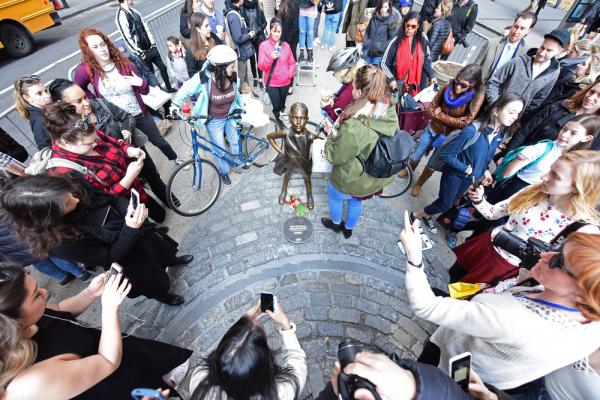The image of the young girl statue standing off against the iconic bull on Wall Street was hard to miss on Facebook earlier this month. She returned to headlines today, as New York City Mayor Bill De Blasio announced that the temporary statue would be granted an extension to remain until February 2018.
The statue was funded by the $2.3 trillion asset manager State Street Global Advisors (SSGA). As the plaque beneath the statue says, SSGA erected the temporary sculpture to highlight “the power of women’s leadership.” It faces the iconic bull, a piece of guerilla art by Arturo Di Modica that has represented Wall Street since 1989. The bull is a symbol of financial optimism, first associated with the financial industry through Merrill Lynch in 1974.
A temporary installation in honor of International Women’s Day, the young girl statue is part of a long tradition of feminist art in New York City. It immediately caught the attention of tourists, CEOs, and social media, and spurred important conversations regarding male dominated industries.
But does this statue symbolize a path forward, or is it simply a reminder of the banality of corporate feminism?
SSGA’s stated intent, to promote highly experienced and educated women, is not demonstrated through an elementary-aged girl. Representing women’s leadership through a young girl infantilizes female leaders in finance, symbolically miniaturizing their degrees and accomplishments. And not by accident: Ron O’Hanley, the CEO of SSGA, noted they didn’t want “a more confrontational pose.”
Across all U.S. investing companies, women hold fewer than 10 percent of top leadership positions. As is true in many fields, women in finance are not promoted as quickly as their male peers in finance. Women in finance are fired more often for misconduct, despite engaging in less costly misconduct than men. SSGA themselves struggle with these disparities: Only 5 of their 28 members are female.
Corporations have corrupted mainstream feminism beyond representation in the boardrooms of Wall Street. Hillary Clinton is the tragic hero of this trend, and her years of public service for women’s and progressive issues were tainted by her close ties to Wall Street. But Clinton is merely a messenger of a larger trend, a feminist movement that, in its effort to be more inclusive, has become more corporate. In her review of the recently-released book Why I Am Not A Feminist by Jessa Crispin, New Yorker writer Jia Tolentino highlights the “vital strain of thought” of offering “unforgiving indictment[s] of individualism and capitalism, value systems that [Crispin] argues have severely warped feminism, encouraging women to think of the movement only insofar as it leads to individual gains.”
The statue will live on Wall Street for a year, after popular support pressured to city to allow the statue beyond its one-week permit. The extension is a small victory. But her removal next year will be a quieter, yet no less important visual: Wall Street’s unwillingness to feature women in a public space without an end date.
The fight for gender parity will likely require years of attention from companies. The removal of the statue suggests that to some of our most prominent institutions, women’s issues are only relevant on International Women’s Day.
The weekend after its installation, a video began to circulate of a suited man sexually assaulting the young girl statue — a sobering reminder that a statue alone does not change workplace sexual harassment and callous attitudes toward women. Perhaps, instead, the statue is a better reflection of where we are — a culture that infantilizes and assaults women, rather than empowering them, as SSGA intended.
The young girl statue is a nice but ultimately ineffective counterweight to the bull of Wall Street. Why did so many celebrate it as an iconic moment for American feminism? In her critique of the statue, Jillian Steinhauer explains the obsession thusly: “We’re so starved for public images of women that aren’t tied to advertising or sex, we’re willing to laud just about anything.”
Simply amending the idol of money, the bull, with an idol to female leadership does not represent true closeness to justice. But as members of the Abrahamic tradition, we can learn much about how to deal with the Wall Street bull from the resolution of the Israelites’ golden calf.
When the Israelites felt the kingdom of God was far away, the golden bull was something comforting and concrete, something to show that they were close to the divine. Moses knew this was false proximity, and that it distracted from the real work of kingdom building: the long journey, difficult politics, and sacrifice. In the same way, the “fearless girl” statue is a placebo, not real progress. Sadly, these placebos can obscure even the real progress being made — SSGA’s new commitment to use their shareholder voting power to promote female leadership was lost in the excited media coverage of the statue.
Deeply angered by the worship of false gods, Moses ordered the statue destroyed, burnt, mixed into water, and drunk by all those who participated (Exodus 32:20). No doubt it was a bitter drink — but it was an essential sacrifice to ensure the same mistake was not made again.
This is exactly the choice feminists must make today: Will we be satisfied with an idol to corporate feminism, or will we make the sacrifices required to stop the corporate corruption of our justice movement?
Got something to say about what you're reading? We value your feedback!

